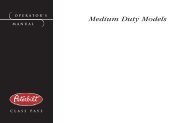Peterbilt Model 320 Operator's Manual after 8-07 - Peterbilt Motors ...
Peterbilt Model 320 Operator's Manual after 8-07 - Peterbilt Motors ...
Peterbilt Model 320 Operator's Manual after 8-07 - Peterbilt Motors ...
Create successful ePaper yourself
Turn your PDF publications into a flip-book with our unique Google optimized e-Paper software.
PART 8: MAINTENANCE AND SERVICE<br />
Fan Clutch / Fan<br />
WARNING!Enginefansengagesuddenlywithout<br />
warning and can badly hurt you. Stay away<br />
from the fan when the engine is running.<br />
Your truck may be equipped with an On/Off or Viscous Fan<br />
Drive. Follow these guidelines to check your engine fan:<br />
• Check the fan assembly mounting bolts for tightness.<br />
Inspect the fan blades for damage.<br />
• On/Off Fan Drives - Check the clutch operation by<br />
starting the engine when it is cold. Idle the engine at<br />
about 800 RPM. Listen for air leaks. Check that the fan<br />
is not working while the engine is warming up. When<br />
the clutch engages, note the reading on the vehicle’s<br />
panel-mounted coolant temperature gauge. If the fan<br />
clutch engages at low engine temperature or cycles on<br />
and off more frequently than it should (receives "false<br />
signals"), have the problem corrected at your dealership.<br />
• Viscous Fan Drives - Check the clutch operation by<br />
starting the engine when it is cold. When the truck is<br />
cold the viscous fan clutch will require more time to<br />
disengage. This time will depend on the engine RPM.<br />
Run the engine above idle and you will audibly notice<br />
Air Cleaners<br />
the fan turning off. If the fan clutch does not disengage,<br />
have the problem corrected at your dealership.<br />
Air Intake System<br />
Engine heat, vibration, and age combine to loosen air intake<br />
connections and cause cracks in the tubing and elbows.<br />
Leaks in the intake system allow abrasive dust to enter<br />
the engine and quickly cause expensive damage. During<br />
your daily walk-around inspection, carefully check all<br />
tubing, elbows, clamps, supports, and fasteners for condition<br />
and tightness.<br />
Under normal operating conditions, we recommend complete<br />
disassembly and cleaning of the air intake system annually.<br />
Under severe operating conditions, such as heavy off highway<br />
use, the disassembly and cleaning should be more frequent.<br />
Replace any defective parts. With the possible exception<br />
of mounting brackets, don’t repair defective parts.<br />
Air Cleaners<br />
The following service information is basic to all air cleaner<br />
makes and models.<br />
R(08/<strong>07</strong>) Y53-6015 – 181 –
















